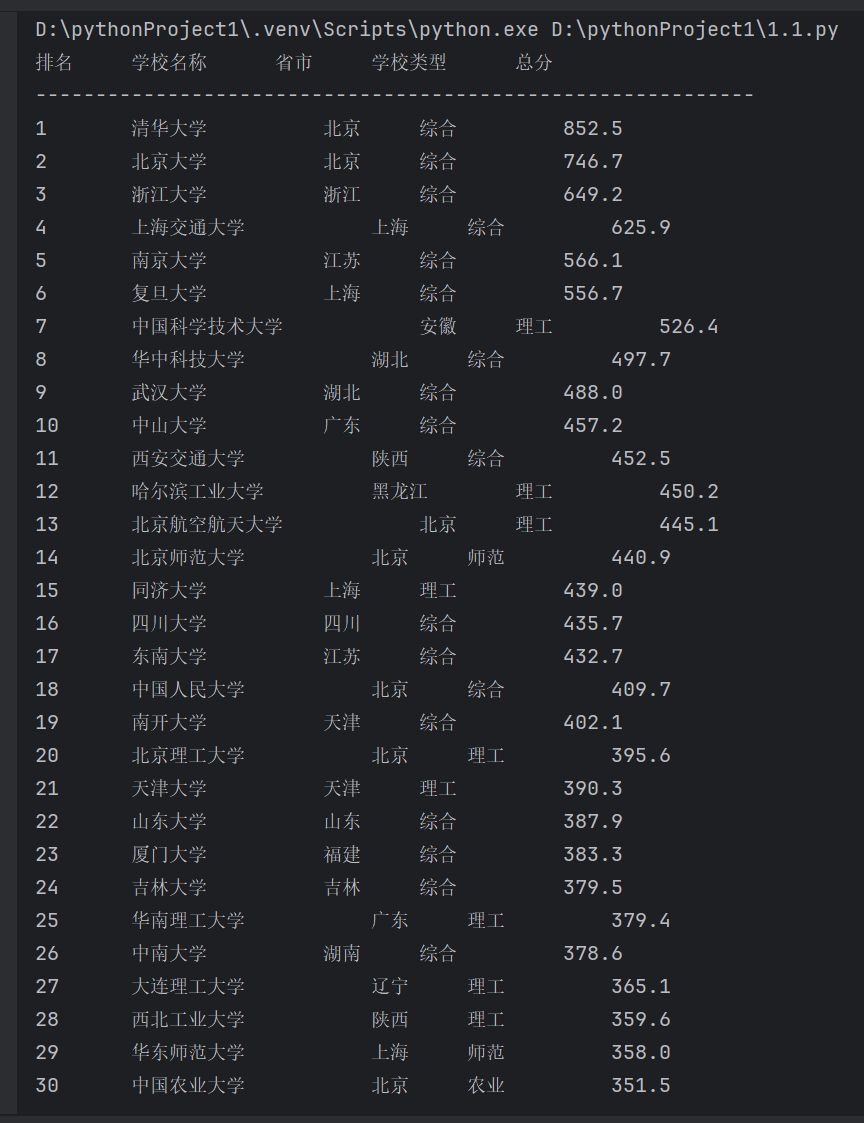数据采集作业1
一.作业①
(作业要求:用requests和BeautifulSoup库方法定向爬取给定网址的数据,屏幕打印爬取的大学排名信息。)
1.代码与运行
(1)代码展示:
import requests
from bs4 import BeautifulSoup
import re
target_url = "http://www.shanghairanking.cn/rankings/bcur/2020"
import urllib.request
from bs4 import BeautifulSoup
目标网址
url = "http://www.shanghairanking.cn/rankings/bcur/2020"
使用 urllib 请求网页内容
response = urllib.request.urlopen(url)
html_content = response.read()
使用 BeautifulSoup 解析 HTML
soup = BeautifulSoup(html_content, 'html.parser')
找到包含排名信息的表格
table = soup.find('table')
打印标题
print("排名\t\t学校名称\t\t省市\t\t学校类型\t\t总分")
print("-" * 60) # 打印分隔线
遍历表格的每一行
for row in table.find_all('tr')[1:]: # 跳过标题行
# 提取每行的数据
cols = row.find_all('td')
rank = cols[0].text.strip()
school_name_full = cols[1].get_text(strip=True, separator=" ")
province = cols[2].text.strip()
school_type = cols[3].text.strip()
total_score = cols[4].text.strip()
# 使用正则表达式匹配中文字符
school_name = re.search(r'[\u4e00-\u9fa5]+', school_name_full)
school_name = school_name.group(0) if school_name else "未知"
# 打印提取的信息,使用格式化字符串确保排列工整
print(f"{rank}\t\t{school_name}\t\t\t{province}\t\t{school_type}\t\t\t{total_score}")
运行展示:

二.作业②
(作业要求:用requests和re库方法设计某个商城(自已选择)商品比价定向爬虫,爬取该商城,以关键词“书包”搜索页面的数据,爬取商品名称和价格。)
1.代码与运行
(1)代码展示:
import requests
import re
假设的商城搜索URL,需要根据实际情况替换
SEARCH_URL = 'https://www.example.com/search?q=书包'
模拟浏览器头部信息,防止被网站拦截
HEADERS = {
'User-Agent': 'Mozilla/5.0 (Windows NT 10.0; Win64; x64) AppleWebKit/537.36 (KHTML, like Gecko) Chrome/58.0.3029.110 Safari/537.3'
}
def get_search_results(url):
response = requests.get(url, headers=HEADERS)
if response.status_code == 200:
return response.text
else:
print("Error fetching the page")
return None
def parse_product_info(html):
# 假设商品信息在特定的HTML标签中,需要根据实际情况调整
# 此处使用正则表达式来匹配商品名称和价格
pattern = re.compile(r'
matches = pattern.findall(html)
products = []
for match in matches:
product_name, product_price = match
product_price = float(re.sub(r'[^\d.]', '', product_price)) # 移除非数字字符并转换为浮点数
products.append((product_name, product_price))
return products
def main():
html = get_search_results(SEARCH_URL)
if html:
products = parse_product_info(html)
print("序号\t价格\t商品名")
print("-" * 20)
for index, (product_name, product_price) in enumerate(products, start=1):
print(f"{index}\t{product_price}\t{product_name}")
if name == "main":
main()
三.作业③
(作业要求:爬取一个给定网页( https://news.fzu.edu.cn/yxfd.htm )的所有JPEG和JPG格式文件)
1.代码与运行
(1)代码展示:
import os
import requests
from bs4 import BeautifulSoup
from urllib.parse import urljoin
import re
def sanitize_filename(filename):
# 移除文件名中不允许的字符
return re.sub(r'[\/*?:"<>|]', '', filename)
def save_images_from_url(url, save_dir):
# 发送HTTP请求
response = requests.get(url)
response.encoding = 'utf-8'
# 解析HTML内容
soup = BeautifulSoup(response.text, 'html.parser')
# 创建一个文件夹来保存图片
if not os.path.exists(save_dir):
os.makedirs(save_dir)
# 找到所有图片标签
img_tags = soup.find_all('img')
# 下载并保存图片
for img in img_tags:
img_url = img.get('src')
if img_url:
# 确保图片格式为JPEG或JPG
if img_url.lower().endswith(('.jpg', '.jpeg')):
# 将相对路径转换为完整的URL
full_img_url = urljoin(url, img_url)
try:
img_data = requests.get(full_img_url).content
file_name = sanitize_filename(full_img_url.split('/')[-1])
file_path = os.path.join(save_dir, file_name)
with open(file_path, 'wb') as file:
file.write(img_data)
print(f'图片已保存:{file_path}')
except requests.exceptions.RequestException as e:
print(f'无法下载图片:{full_img_url},错误信息:{e}')
目标网页URL
url = 'https://news.fzu.edu.cn/yxfd.htm'
save_dir = 'downloaded_images'
save_images_from_url(url, save_dir)
运行展示:

心得体会:
代码结构和逻辑
- 模块化设计:代码被分为几个函数,每个函数负责特定的任务。这种模块化设计使得代码易于理解和维护。
- 异常处理:在
get_search_results函数中,通过检查响应状态码来处理可能的错误,这是一种良好的编程实践。 - 正则表达式:使用正则表达式来解析HTML内容是一种常见且有效的方法,但需要注意正则表达式的复杂性和性能问题。
代码的局限性
- 假设性:代码中使用了假设的URL和HTML结构,这在实际应用中需要根据目标网站的具体情况进行调整。
- 反爬虫策略:实际网站可能有反爬虫机制,如动态加载内容、验证码、IP限制等,这需要额外的处理。
- 性能考虑:如果目标网站内容量大,需要考虑分页处理和请求频率控制,避免对服务器造成过大压力。
代码的改进方向
- 动态内容处理:对于动态加载的内容,可能需要使用Selenium等工具来模拟浏览器行为。
- 反爬虫策略应对:可能需要设置请求头、使用代理IP、处理Cookies等策略来应对反爬虫机制。
- 代码优化:对于正则表达式和HTML解析部分,可以进一步优化以提高性能和准确性。
代码的合规性和道德考量
- 遵守法律法规:在进行网络爬虫开发时,必须遵守相关法律法规,尊重网站的版权和隐私政策。
- 道德责任:合理使用网络爬虫,避免对网站造成不必要的负担,尊重网站的
robots.txt文件。
总结
编写网络爬虫时,需要考虑代码的结构、性能、合规性和道德责任。通过模块化设计、异常处理和正则表达式等技术,可以有效地提取和处理网页数据。同时,需要关注网站的反爬虫策略,并采取相应的应对措施。最重要的是,要确保网络爬虫的使用符合法律法规和道德标准。




